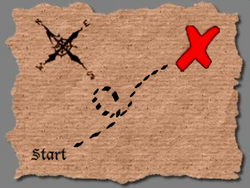Hyphenation
| Hyphenation | |
| Also Known as | "Hyphen-ation", "Hifu-nation" |
| Motto | Never hyphenate a five-letter word un-less you are us-ing 72-point font. |
Hyphenation is where the hyphens are on this map. The two hyphens that are crossed-over each-other are mat-ing (that is why they are glow-ing red)-- and if you read the code of hyphenation, you will see they are mating il-legal-ly. The part that looks like the word "start" is actual-ly some very flex-ible con-tortionist hyphens-- they are also out-laws. | |
The national flag of Hyphenation. Red is the sym-bol of blood (in re-ference to chop-ping), and white is the sym-bol of pur-ity (in re-ference to stay-ing straight). |
The national coat-of-arms of Hyphenation. The vert-ical hyphen float-ing above the period is sym-bolic that hyphens should take pride and not lay-around so much. In fact, period-hover-ing is one of the things hyphens look best do-ing. |
| Official languages | En-dash (you can get a sample of this language here) |
| Demographic noun | Hyphen, en-dash |
| Demographic adjective | Hyphenese |
Hyphenation, some-times erroneous-ly spelled Hyphen-ation or Hifu-nation, is a country some-where in the far-off land of Grammar.
Indigenous peo-ples[edit]
Residents of Hyphenation are known as hyphens or en-dashes. They are typical-ly re-present-ed by a horizo-ntal line hover-ing between blue lines when they travel on notebook pages.
Demo-graphics[edit]
You can get a samp-le of the graphics by play-ing the demo a-vailable for free down-load at the o-fficial national web-site of Hyphenation. Un-fortunately, we for-got the URL and the IP-address of their se-rver.
National Law[edit]
There are lots of laws in the country of Hyphenation. The National Board of Hyphen Rule-Makers (consisting of twenty-one hyphens[1] who be-lieve they are quali-fied to dis-cuss law) is a com-mit-tee that stays awake on ev-ery third Satur-day night drink-ing and the next morn-ing with a hang-over. Their other purpose is to meet with one-another dur-ing that hang-over at the Capital-Letter Town-Hall to dis-cuss what sort of laws they can make-up for their nation and when to put them in-to effect.
Most of the laws is-sued in Hyphenation get re-pealed be-fore long, due to the poor law en-forcement that seems to be com-mon through-out the land of Grammar. Law-abid-ing citi-zens and grammar-police are typical-ly shunned by those who do not under-stand the law.
Here one more re-cent version of the Code of Hyphenation:
CODE OF HYPHENATION
I. BEHAV-IOR IN THE PRES-ENCE OF PERIODS
- a. When not period-floating as direct-ed in the coat-of-arms, hyphens should both avoid be-ing near periods and al-so remain in a laying-down po-sition.
- b. If a period express-es it wishes to be a decimal then the hyphen may a-ccompany it, as long as it lies down next to it (optional-ly with numbers sep-arating them).
II. CODE OF CON-DUCT WHEN CHOP-PING
- a. If a word is too fat to fit on one line, then a hyphen is al-lowed to chop the word in half.
- b. Five-letter words and words with only one syl-lable are exempt from the treat-ment de-scribed in Section II.a.
- 1. The number of syl-lables in a word will be de-termined during the case in the court-room by the judge, de-pend-ing on whether he pre-fers British-English, American-English, or ESL-English.
- c. Hyphens may chop hyphens, as long as they are re-placed with that double-hyphen char-acter not found in the char-acter set a-vaila-ble to most ty-pists in most count-ries (⸗). This can be ac-complished by tak-ing two hyphens and lay-ing one above-the-other and slant-ing them one di-rection.

III. CODE OF CON-DUCT WHEN JOIN-ING
- a. Hyphens may join two or more words to-gether if those words like each other and make sense as a sin-gle word. Only one-of-the words may be male, but a male doesn't have to be pre-sent.
- b. If a di-vorce is desired, the hyphen may act as a coun-selor pro-vided he or she does not hurt the feel-ings of the two or more words in-volved.
IV. MAT-ING
- a. This section has been re-pealed and has not yet been re-placed with a new law.
- b. If a hyphen wish-es to chop a sentence, mating is required.
- c. Only two hyphens per set-- We don't sup-port poly-gamy even though we are o-kay with it in words as in-dicat-ed in section III.a.
- d. Mating hyphens must get really close to-gether in impor-tant typ-ed do-cuments and in all hand-written do-cuments. Fus-ing should be done end-to-end, not in the mid-dle. Once fus-ed to-gether, call your-self an em-dash.
- e. In less impor-tant typ-ed do-cuments such as read-me files, fus-ing is pro-hibited be-cause the fus-ed char-acter is not avai-lable to the ty-pist. In-stead, hyphens should just lie next to one-a-nother.
- f. If em-ployed as a math-emati-cian, hyphens may not fuse. Instead, they should lie on top of each other or stay single.
V. COMMON-SENSE
- a. No be-ing curv-y or kink-y.
- b. Be the same co-lor as the sur-round-ing peo-ple. We are a se-gre-ga-tion-ist nation.
- c. Never touch the bot-tom line on the paper un-less you are be-ing de-moted as an under-score.
- d. No talk-ing. Ever. You are re-quired to ut-ter your vow-of-silence in your head rath-er than a-loud.[2]
- e. Be straight and make sure your orient-ation is cor-rect.
VI. OTHER
- a. You are to explicitly ignore section VI.a.
- b. All vio-lators of the law are sub-ject to harsh scold-ing and de-hyphen-ation.
References[edit]
- ↑ Twenty-one is the number of hyphens se-lected for the National Board of Hyphen Law-Makers due to the fact that 21 is the first number that can legal-ly be chop-ped by hyphens. Pri-or to the passing of Section II.b., this number was three, which in ESL-English is a two-syl-lable-word. When chop-ped, "three" was spelled "th-ree", "t-ree", or "th-lee".
- ↑ A new law known as Pho-netic Punc-tu-ation, sug-gested by Vic-tor Bor-ge, is under con-sideration man-dat-ing that all punc-tu-ation marks should be re-quired to speak. Un-der this new man-dation, hyphens would be re-quired to say, "-", which is pro-nounced phwhhhHHHXXXX.



